Home Page › Blog › How to Get a Service Dog
How to Get a Service Dog
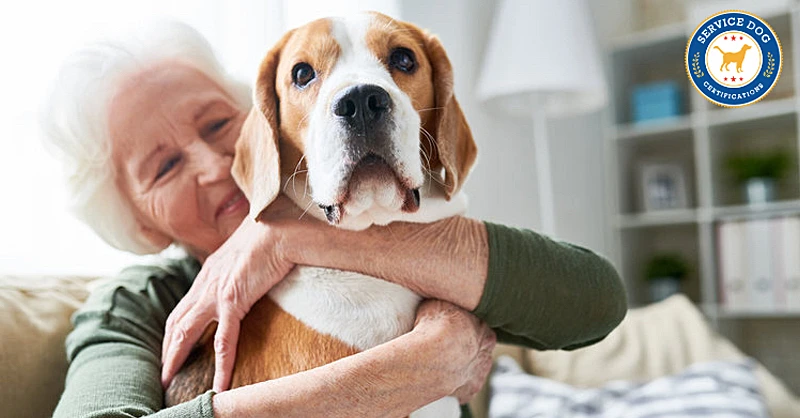
Have you ever wondered what a service dog can do and what steps are needed to acquire one? A service dog is a canine trained to perform tasks for a person with a physical or mental disability. The job completed by the service dog has to be directly related to the handler’s condition. In this article, we will explain in detail everything you need to know on how to get a service dog.
Steps to Get a Service Dog
There are a few steps and considerations involved in selecting, training, and utilizing a service dog:
- Select a dog to be your service animal
- Train your service dog, on your own or with professional help
- Make sure your service dog is ready for public environments
- Understand your rights as a service dog owner
- Understand how to register your service dog, use equipment and respond to public inquiries
Step # 1 – Select a dog to be your service animal
The type of dog you choose to be a service animal depends on your physical and mental health needs. Large dogs (like Golden Retrievers, Labrador Retrievers, and German Shepherds) and smaller breeds (such as Poodles) work as useful service dogs for their owners. Larger service dogs are more appropriate for physically demanding tasks such as pulling a wheelchair or traversing through crowded streets. However, smaller service dogs also have advantages, such as being easier to handle for some owners and requiring less space.
The temperament of the dog and its personality are also important considerations. While stereotypes and general characteristics about a breed may be helpful to know, the specific personality traits and quirks of a dog can vary widely within breeds. That is why it is also important to spend some time with the dog you are considering adopting to get a sense of its character.
A service dog should have a stable temperament, particularly if the dog will be working in stressful environments such as crowded areas or if the service dog will need to respond to crises. A service dog should also be alert, responsive, and highly receptive to training. No matter what breed of dog is selected, a service dog should maintain its attention on its handler. It needs to be under control at all times, tune out unnecessary distractions (especially in busy, noisy environments), and be consistently dependable to perform the tasks they were trained for.
Selecting the right dog as service dog can be time-consuming, but finding a dog with the right temperament and physical abilities is key to getting a service dog.
Service Dog Certifications
Training a service dog is a time-consuming and substantial investment. Service dog owners will want to ensure to the extent possible that the dog they adopt is healthy. Young canines with a clean bill of health are ideal choices for handlers, as they may respond better to training and have a greater lifespan than an older dog. Older dogs, however, can also make great service dogs, especially ones with prior training. It’s important to recognize that it may be more difficult to break bad habits in older dogs and that an older dog will have a shorter lifespan.
It’s also important to consider how much maintenance a dog may need. For example, a dog that is constantly shedding and requires routine cleanup may be less favorable for some owners than a dog that sheds less and is hypoallergenic. Some dogs also require a high degree of activity and mental stimulation, while others are content with being more sedentary.
A service dog is an incredibly worthwhile investment but requires time, resources, and long-term commitment. Choosing the right dog for the job from the outset is important for service dog handlers, but perhaps more important is the training the service dog receives, which we will discuss in the next step.
Step # 2 – Train your service dog, on your own or with professional help.
The essence of a service dog is that it must be trained to do work or perform tasks for its handler. Training your service dog can be done on your own or with a professional trainer. There is no official qualification program under the ADA for service dogs. Owners of service dogs fully have the right to train their service dogs on their own, and there is no requirement to use a professional training program.
If you have the skills, time, and patience to train your dog, it can be a wonderfully rewarding experience. The training process itself can help strengthen the bond between the handler and their service dog. For those who need help, there are professional trainers available and organizations that provide guidelines for proper service dog training. For example, one organization recommends a minimum of 120 hours of training over a period of six months or more, with at least 30 hours dedicated to public excursions that will train the service dog to work effectively in real-world settings.
In addition to being trained for the tasks required by its handler, a service dog must master basic commands and be well-behaved in all settings.
Service Dog Certifications
A service dog should have the following qualities:
- No aggressive behavior towards other people or animals (i.e., no biting, growling, lurching, chasing or excessive barking).
- No begging for food or attention from other people while working.
- Ability to be controlled calmly on a leash without tugging or darting when distracted.
- No sniffing behavior while working.
- No hyperactivity or excited behaviors
- Ability to tolerate novel stimuli in busy environments.
- No unruly behavior in public settings.
- No relieving itself in public places unless given permission to do so by its handler.
Whether you decide to train your service dog on your own or use professional help, the important thing is that your service animal is fully trained to perform the tasks required by your disability.
Prospective service dog owners should be aware that under ADA rules, the service dog must already be fully trained before it can accompany the owner in public settings. That means a service dog in training is not yet considered a service dog. However, some State and local rules provide protections for service animals in the process of completing their training.
Step # 3 – Make sure your service dog is ready for public enviroments.
After your service dog has been trained, you will want to ensure that it is ready to handle real-world situations. Training a service dog at home is fine, but those “controlled environments” cannot replicate the unpredictability of public settings.
Some organizations provide tests that can help determine whether your service dog is ready to perform in real-world settings. And some trainers and programs can provide public access tests to determine whether your service dog is ready. However, these tests do not confer any “official” status on a service animal and are completely optional for handlers.
As a service dog can accompany its owner everywhere, it must be trained to master any situation in any public environment.
Service Dog Certifications
A service dog owner will want to make sure their dog has been trained to have certain abilities that will help it master being in public environments.
Test your service dog ability to do the following:
- Tune out distractions in busy and noisy environments while on duty.
- Safely navigate streets that have vehicular and pedestrian traffic.
- Navigate tight quarter environments such as store aisles and restaurants.
- Behave appropriately when approached by children.
- Remain calm in the presence of other dogs and animals.
- Not become easily distracted by objects on the ground or food.
Before bringing a service dog into a public setting, it’s also important to ensure the handler is also adequately prepared. Under ADA rules, a service dog must be under the control of its handler at all times. The handler should be able to control the service dog using voice, signal, or other methods, recover control if a leash is dropped, and deal with inquiries from other people and staff members in public establishments regarding the service dog.
Step # 4 – Understand your rights as a service dog owner.
Under the ADA, a service dog must be allowed in all areas where the public can go. This applies to businesses and public property. Some examples of venues where service dogs must be allowed are:
- Restaurants
- Theaters
- Malls and retail outlets
- Grocery stores
- Hospitals
- Hotels
- Public transportation
- Gyms, bowling alleys, arenas, stadiums and other entertainment facilities
- Libraries and schools
Facilities must allow service dogs even in cities where local rules prohibit the service dog’s particular breed. An establishment may only exclude a service animal if it behaves in a way that poses a direct threat to the health and safety of others or is not under the control of the handler. That is another reason why it is so important that your service animal is appropriately trained and capable of being kept under control.
A service dog is a vital part of its owners’ well-being and enjoys protection by various federal and state laws.
Service Dog Certifications
According to the Air Carrier Access Act, service dogs also have the right to travel with their handlers in the airplane cabin, free of charge. Service dogs and their handlers also have certain housing rights under the Fair Housing Act and various State laws. These housing protections allow handlers to live with their service dogs, even in buildings that ban animals. Landlords are not allowed to charge a fee or pet deposit for a service dog.
Step #5 – Understand how to register your service dog, use equipment and respond to public inquiries
When out in public, service dog owners have a right to privacy regarding their disability. If it is obvious to an observer that the dog is a service animal, the staff at an establishment cannot bother the handler about their disability or need for the service dog.
However, in situations where it is not immediately apparent that the dog is a service animal (for example, if the service dog is used for a psychiatric condition or only during sporadic emergencies), the staff may only ask two questions:
- Is the dog a service animal required because of a disability?
- What work or task has the dog been trained to perform?
Third parties are not entitled to any further information. Staff members cannot request documentation for the service dog, ask that the dog demonstrate its ability to perform its task, or ask questions regarding the handler’s disability. Disability laws were designed, so that service dog handlers do not have to undergo invasive scrutiny or questioning.
Service dog owners commonly use accessories such as vests, IDs, tags, harnesses, and service dog certification to signal to members of the public that their dog is a working service animal. These accessories are not mandatory and do not by themselves certify that a dog is a service animal, but they are useful and popular with service dog owners.
Service dog accessories and registration IDs are not required but can help owners communicate their need for the service dog’s presence in public.
Service Dog Certifications
Registering your service dog with an organization and obtaining vests, ID cards, harnesses, and other accessories is an effective way to inform the public that your animal companion is a service dog. These tools can help prevent intrusive inquiries about your service dog. They also help warn members of the public that they should not play with, pet, or feed your service dog while it is on duty. Many service dog owners who are anxious about being interrogated about their need for their service dog find these tools to be useful.
Service Dog Tasks
Service dogs are employed to help with a wide variety of disabilities. Below are a few examples of the important duties that service dogs are called upon to perform for their handlers:
- Helping the blind navigate public areas.
- Pulling a disabled person’s wheelchair.
- Reminding someone with a mental illness to take their medication.
- Providing pressure therapy to calm someone in an agitated psychiatric state, such as a severe anxiety attack or an episode relating to post-traumatic stress disorder.
- Opening doors for someone with limited mobility.
- Alerting someone to an oncoming health issue such as a drop in blood sugar.
- Preventing the handler from harming themselves while experiencing a seizure by protecting their head.
- Picking up dropped items, and retrieving/carrying items such as mail for someone with mobility issues.
Regardless of the work these amazing dogs perform, these canine companions are vital to the individuals that need them. Under the Americans with Disabilities Act, service dogs are not considered pets and have special legal rights. Under the ADA, businesses and state and local governments must allow service dogs to accompany their handlers in all areas of the premises where the public is allowed. Any grocery store, hotel, beach, or restaurant open to the public must allow a handler to be accompanied by their service dog.
Service Dogs Are Not to Be Confused with Emotional Support Animals
Emotional support animals have more limited rights than service dogs. Owners of emotional support animals have the right to be accompanied in their homes under the Fair Housing Act. Unlike service dogs, ESAs do not require any special training and provide support to their owners by their mere presence for mental and emotional health issues.
Many people with psychiatric conditions utilize service dogs, but for some people who suffer from mental or emotional health issues, an emotional support animal is more appropriate. An ESA requires an ESA letter from a licensed counselor, therapist, or doctor.
The main difference between service dogs and emotional support animals is that service dogs require specialized training and have much greater rights to accompany their owners in public places.
Service Dogs Play an Indispensable Role in the Lives of Disabled People
Owners of service animals enjoy many rights under the ADA and other disability laws. Service dog owners benefit from their service dogs in many ways. Prospective service dog owners should carefully consider these steps mentioned in this article before adopting and training a service dog. Owning a service dog is a major responsibility that requires dedication and commitment. But service dog owners will agree that the rewards are worth the effort.
Unable to train your dog as a service dog?
You may be interested in an Emotional Support Animal instead. ESAs do not require specific training and have access to no-pet apartments. Click here to learn more about ESAs.
About the Author: The writing team at Service Dog Certifications is made up of folks who really know their stuff when it comes to disability laws and assistance animals. Many of our writers and editors have service dogs themselves and share insights from their own experiences. All of us have a passion for disability rights and animals.
7 comments
Leave a Reply Cancel reply
Latest Posts

Ohio Service Dog Requirements
You can bring a service dog almost anywhere where pets aren’t allowed in Ohio as long as you meet all the necessary requirements. The rights of service dog handlers in the Buckeye State are covered under federal and state laws. This guide will walk you through Ohio’s legal requirements for service dogs. Ohio Health Requirements […]

Read More

How to Bring a Service Dog to Disneyland
Trained service dogs are more than welcome to join their handlers at Disneyland. In this guide, we’ll explain Disneyland’s policies and give practical advice for bringing a service dog to Disneyland for the first time. Disneyland’s Service Dog Policies The Magic Kingdom is happy to welcome trained service dogs across most park locations! They kindly […]

Read More

Can Dogs Eat Tomatoes?
Yes! Dogs can safely enjoy tomatoes, but there are a few risks to be aware of so you can feed your dog responsibly. Fully ripe tomatoes (without the stems and leaves) can actually have nutrients that are good for your pup. Tomatoes have chlorogenic acid, an antioxidant that can have anti-inflammatory effects in cells. They’re […]

Read More

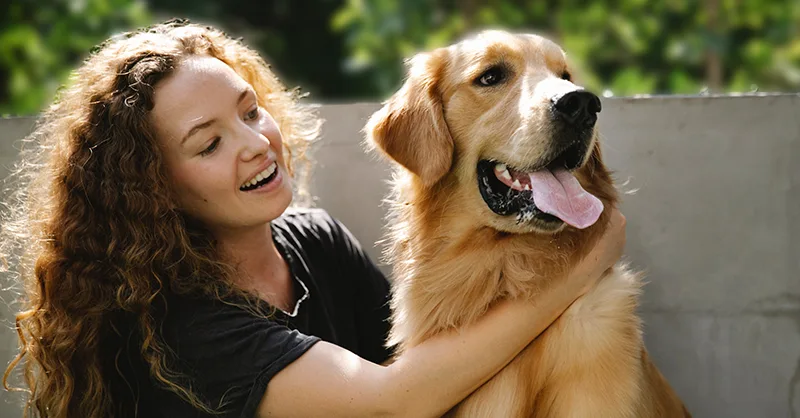

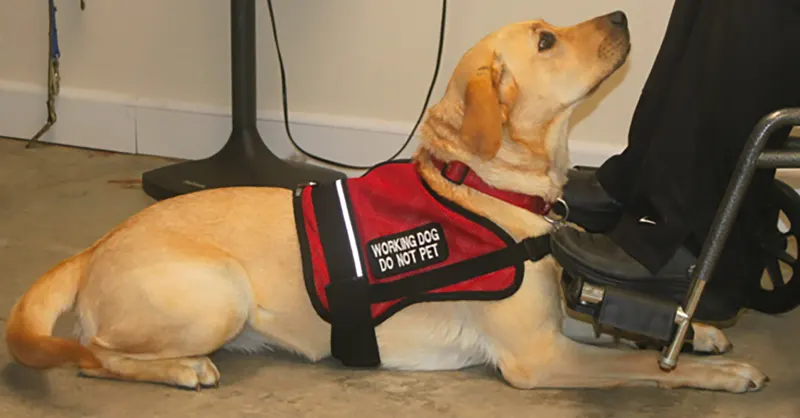
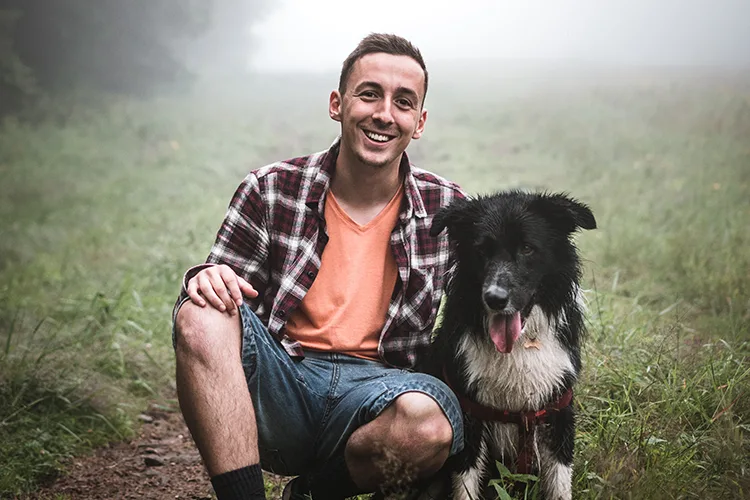
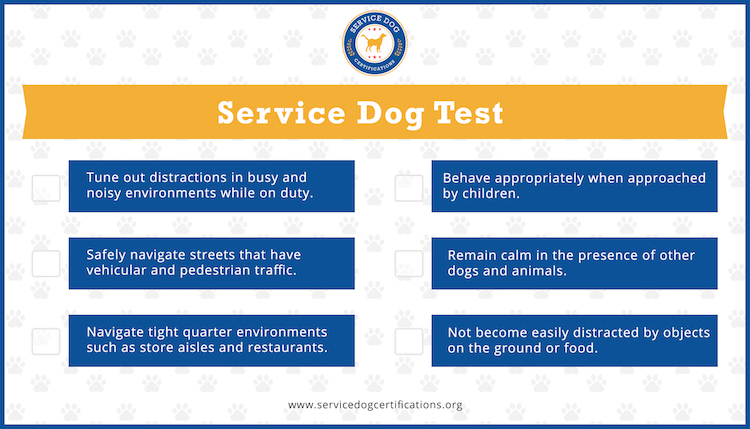
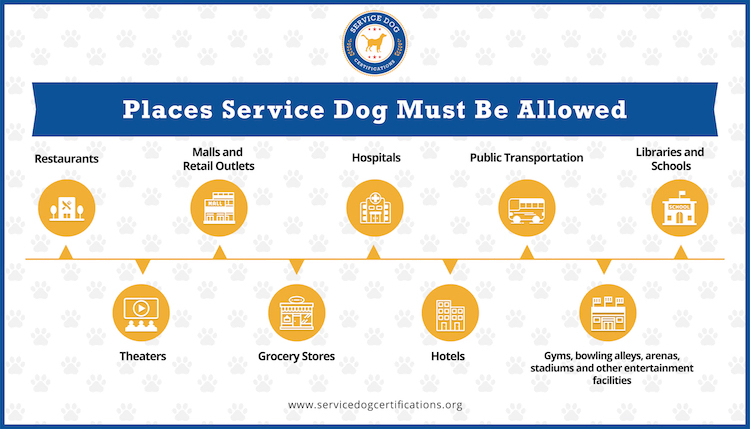
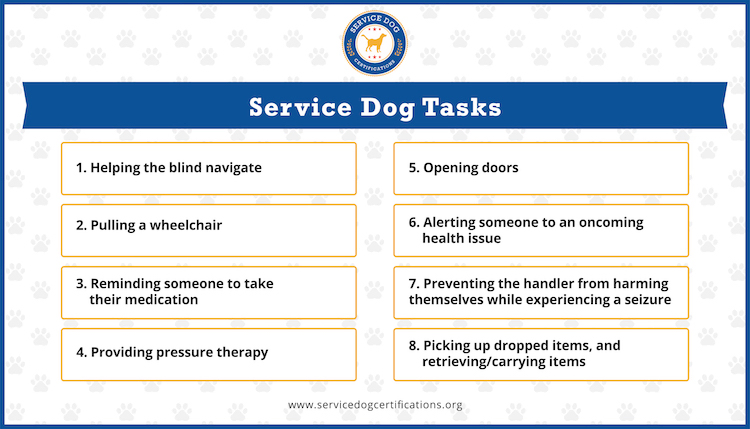



Does my dog have to be certified before I can start to train them in a store or public areas? Like you see shows where trainers are taking little puppies into stores with “in training” vest. Is that something only professional trainers can do or I can do that too?
Unfortunately, a service dog in training isn’t technically a service dog yet. Establishments do not need to grant access until you have fully trained your dog. Training your dog in public areas is important for them to learn to focus on their tasks while in high-stress situations. But you may need to check with the establishment beforehand if they will welcome your service dog in training. You may find this article on public access test for service dog interesting https://www.servicedogcertifications.org/public-access-test-service-animals/
My son suffered a traumatic brain injury due to a motorcycle accident. His balance is off and sometimes falls with difficulty getting up. My problem is we have a dog and a trainer but we were told we need a script from his dr. In order to train the dog for mobility issues. I’m in Nj and the dr treating him for his injury knows nothing bout the paperwork needed. Said there are certain forms etc to be filed out. Can someone help us with this?????
Your sons issue appears to be more of a physical disability rather than an emotional or psychological one and therefore does not require any paperwork for having a legitimate service animal trained for his needs…none whatsoever. Alan
I am in need of a service dog. I have ptsd, depression and mobility issues. I occasionally have seizures.
Where can i get one?
I have trained dogs over 20 years. Never in my life have i seen a dog that doesnt go to the bathroom in public and only goes to the bathroom on command.
Am i supposed to sit in my house the rest of my life to be with my service dog? Am i supposed to train him to only go to the bathroom in my house? Thats somewhat ridiculous. I feel like once again, my combat ptsd will make that i never get out in public